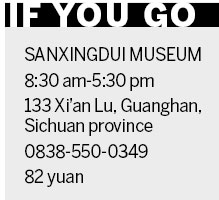Mystery of Majestic man
Updated: 2012-06-18 16:49
By Huang Zhiling (China Daily)
|
|||||||||||
 |
|
The standing bronze statue in the Sanxingdui Museum. Huang Zhiling / China Daily |
A mysterious bronze statue in Sanxingdui Museum near Chengdu, the capital of Sichuan province, has attracted droves of fascinated visitors. Huang Zhiling finds out more.
Among the most mysterious displays at the Sanxingdui Museum in Guanghan, near the Sichuan provincial capital of Chengdu, is a bronze statue of a barefoot man.
With anklets and clenched fists in an exaggerated pose, the 2.62 meter high, 180-kilogram statue is believed to represent a king or a great sorcerer during the Shu Kingdom, the name for Sichuan in ancient times. It symbolizes an integration of theocracy and monarchy.
Dating back about 3,100 years, the statue is crowned with a sun motif and coated with three layers of tight, short sleeved bronze "clothing" decorated with a dragon and overlaid with a checked ribbon.
"The garment could be the country's oldest existing dragon robe," says Huang Nengfu, a professor of the Academy of Art and Design at Tsinghua University and an eminent researcher in Chinese clothing from different dynasties. He also thinks that the pattern is the work of the famous Shu Embroidery, an intangible heritage of Sichuan.
Cooperating with a famous garment producer in Beijing, Huang reproduced the silk robe and donated it to the Chengdu Shu Brocade and Embroidery Museum in 2007, where the robe is now on display.
The robe has also changed the traditional view that Shu Embroidery began in the mid-Qing Dynasty (1644-1911). Instead, it shows that Shu Embroidery appeared in the Shang Dynasty (c.16th century-11th century BC), according to Wang Yuqing, a Taiwan-based Chinese clothing historian.
The archeological discoveries in Sangxindui Ruins, near the museum, have re-written China's history.
"Before the excavation of Sanxingdui, it was believed that Sichuan had a history dating back to 3,000 years. Thanks to the excavation, it is now believed that civilized culture first appeared in Sichuan 5,000 years ago," says Chen Xiandan, deputy curator of Sichuan Provincial Museum.
Sanxingdui, which means "three star mounds" in English, is so named because the ruins are located in a village where there were three mounds.
The ruins, located on the upper reaches of the Yangtze River, also serve as a convincing proof that the origins of Chinese civilization are diverse, archaeologists say.
They say that the Sanxingdui Ruins dispel theories that the Yellow River was the sole starting point of Chinese civilization.
"The discovery of the San-xingdui Ruins was accidental," Chen says. "The treasure had been buried there for thousands of years and nobody knew it. It seemed to appear from nowhere."
In the spring of 1929, Yan Daocheng, a villager in Guanghan, found a stone while digging a ditch in his fields. Removing the stone, he found a hole beneath it. In the hole were objects made of jade.
Fearing that fellow villagers might learn about his discovery, Yan immediately covered the hole with the stone and mud, and returned home.
Later that night, Yan and his family re-dug the hole and removed more than 400 jade objects.
Yan later sold some of the objects in Chengdu, arousing the attention of cultural relics dealers.
They flocked to Guanghan, attempting to purchase more.
"The popularity of Guanghan jade in turn attracted the attention of archaeologists," Chen says.
 |
In 1933, an archaeological team from Huaxi University in Chengdu headed for San-xingdui to undertake the first formal excavation of the ruins.
Since then, several generations of archaeologists have toiled at Sanxingdui and more than 10,000 relics dating between 5,000 and 3,000 years ago have been unearthed.
Archaeologists around the world were excited by more discoveries in the 1980s. They included the remains of large palaces in 1980, the remnants of eastern, western and southern walls in 1984 and the discovery of two large sacrificial pits in 1986.
The discoveries prove that Sanxingdui contains the ruins of an ancient city that was the political, economic and cultural center of the ancient Shu Kingdom.
Almost all relics unearthed from the ruins are displayed in the Sanxingdui Museum.
Opened to visitors in late 1997, the museum has drawn some 10 million visitors from different parts of the world who are fascinated by its unique displays.
Contact the writer at huangzhiling@chinadaily.com.cn.
Related Stories
A museum's masterpiece 2012-05-18 13:03
Nanjing University History Museum and Art and Archaeology Museum 2012-05-17 09:08
Glass artworks museum in Chengde, Hebei 2012-05-09 15:34
Sichuan Cuisine Museum 2012-04-12 15:55
Museum marks 10th 2012-03-29 10:46
Today's Top News
Rescuers race against time for quake victims
Telecom workers restore links
Coal mine blast kills 18 in Jilin
Intl scholarship puts China on the map
More bird flu patients discharged
Gold loses sheen, but still a safe bet
US 'turns blind eye to human rights'
Telecom workers restore links
Hot Topics
Lunar probe , China growth forecasts, Emission rules get tougher, China seen through 'colored lens', International board,
Editor's Picks

|

|

|

|

|

|





